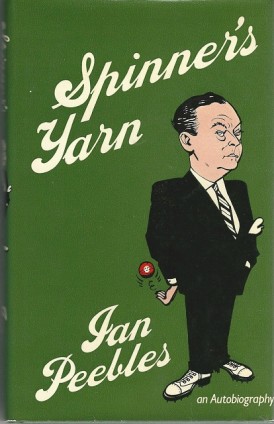Spinner’s Yarn
Tim Dale Lace |Published: 1977
Pages: 222
Author: Peebles, Ian
Publisher: Collins
Rating: 4 stars

I have a special interest in cricketers from The Golden Age, but I must confess that I knew very little about Ian Peebles aside from his being a cricket journalist for The Times and an international cricketer. He is very humble about his international cricket achievements and although Spinner’s Yarn is an autobiography, the spotlight is seldom just on Peebles.
Peebles is proud to be Scottish and his book starts with his rural upbringing in Scotland and is full of nostalgic cricket stories from that time. He describes the day his father took him as a thirteen-year-old, to see the 1921 Australians, as “the most memorable day” of his “young cricketing life”. In 1923 he acted as a tour guide to a few players from the county team, Leicestershire. His father was a club cricketer who, on the day his first son was born in Aberdeen, made a hundred on the Aberdeenshire cricket ground, Mannofield, that incidentally, is the last ground in Britain on which Don Bradman made a century. When Peebles was two the family moved to Wick in Caithness where his first recollection is of his mother telling the family there was going to be a great war. Little did he know then the effect that a quarter a century later the Second World War would have on him, both physically and mentally!
In the mid 1920s Peebles moved to London and took the job of personal secretary to the famous South African all-rounder, Aubrey Faulkner. He paints a picture of a complex relationship between himself and Faulkner that I find very interesting. Faulkner is famous for his cricket school, the Faulkner School of Cricket, where Peebles worked with him.
Master and servant were contrasting people with different views on life, but it is clear that Peebles had a great respect for Faulkner and that his employer had a positive and lasting influence on Peebles’ playing career. Their friendship was tested at times, particularly when they had a fall out over differing aims for the school; Peebles wanted to make the school financially viable whereas Faulkner was in it for the love of the game.
Because Faulkner had respect for him as a player, he coached Peebles in the nets. Without this friendship and guidance, Peebles is certain he would never have played for England. Once picked for England he never convinces you he was actually quite good enough and this is further testament to his modesty because, if you read quotes from none other than Bill Woodfull and Don Bradman, who both spoke highly of his bowling, you will gather that he was far better than he would have you believe. Whilst I knew that Peebles had played Test Cricket before reading his story, I did not know that he troubled a great like Woodfull and dismissed The Don in 1930. I was pleased to read that after that success, and following their fallout in 1928, Peebles and Faulkner patched things up before the latter’s tragic suicide in 1930.
All in all Spinner’s Yarn follows a satisfying sequence from its author’s childhood in Scotland right through to the end of his time as a cricket journalist for the Times. Personally, I feel modern autobiographies rush in to the playing days and come to an abrupt end at retirement but Peebles’ book does not do that. It gives us a full picture of the man.
Sadly, Peebles’ own First Class career effectively ended when he lost his eye during the blitz. This came about when his office took a direct hit from a bomb as he stood on the pavement with a small crowd of people. He suffered ongoing leg pain in the left leg and the right foot from the blast. Peebles however, is characteristically matter-of-fact about this and the other times when things went against him and as always, turns attention away from himself.
Much of the book is concerned with Peebles’ career with Middlesex, who he captained in 1939, and work as a cricket reporter for various publications. This was in an era when with the press box was full of cricket journalists who give me the impression that they had some classical journalism education! The eloquent reporting from John Arlott, Neville Cardus and ‘Crusoe’ Robertson-Glasgow, for example, are synonymous with classic cricket writing. I doubt that the reputation of the writing from many of today’s journalists, chosen from the pool of ex-players, will ever reach the heights of those greats.
Overall, it is a thoroughly enjoyable read, full of surprises and with that in mind, I give it four out of five stars.




Leave a comment